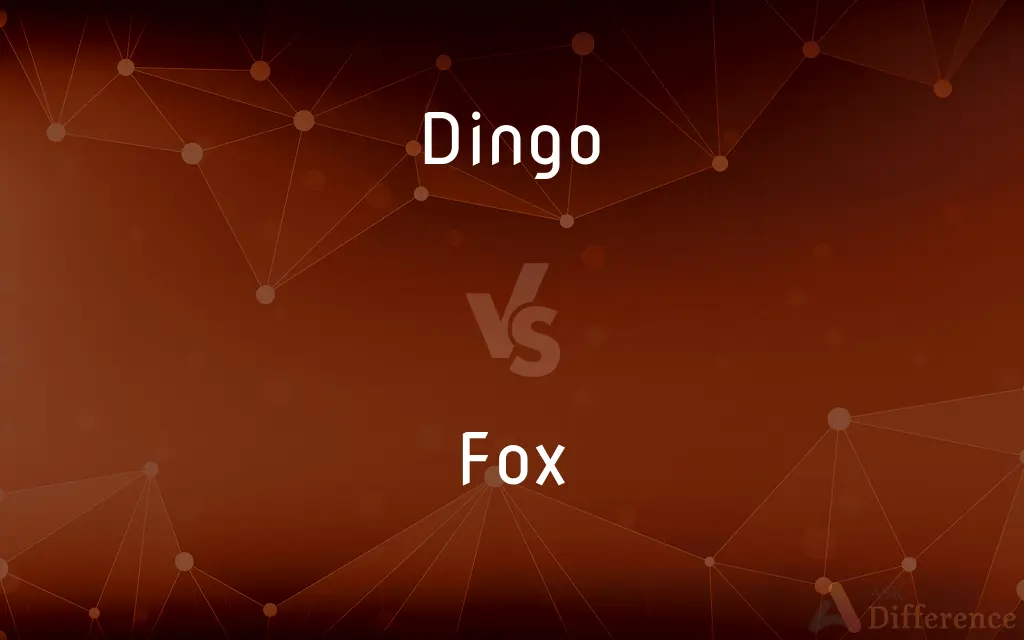Dingo vs. Fox — What's the Difference?
By Tayyaba Rehman & Urooj Arif — Updated on March 8, 2024
Dingoes are wild canines native to Australia, known for their distinctive howl, while foxes are smaller, more adaptable canines with a widespread global presence.

Difference Between Dingo and Fox
Table of Contents
ADVERTISEMENT
Key Differences
Dingoes, often considered Australia's wild dog, are larger than most foxes, with a more robust build and a distinctive reddish to yellow fur. Foxes, on the other hand, are smaller, with a variety of species displaying a range of colors from red, brown, to gray, and are known for their bushy tails and pointed snouts. This size and appearance difference reflects their adaptation to different environments and lifestyles.
While dingoes primarily inhabit Australia and parts of Southeast Asia, they tend to live in packs and are apex predators in their ecosystem, playing a crucial role in maintaining the balance by preying on a variety of animals. Foxes are more versatile, found in almost every habitat around the world, including forests, deserts, mountains, and even urban areas, where they often live solitary lives except during mating season.
Dingoes have a unique howl, used for communication across long distances within their pack, which distinguishes them from domestic dogs and other canines. Foxes are known for their wide range of vocalizations, including barks, screams, and howls, which serve various communication purposes, from signaling territory to interacting with their offspring or partners.
In terms of behavior, dingoes are known for their wariness of humans and have remained relatively undomesticated, even though they occasionally come into contact with human populations. Foxes exhibit a remarkable ability to adapt to human presence, with some species like the red fox becoming common in urban environments, showcasing their opportunistic feeding habits and intelligence.
The relationship between humans and these canines differs significantly; dingoes are often seen as a threat to livestock in rural Australia, leading to conflict. In contrast, foxes, while sometimes considered pests, have been integrated into folklore and stories across cultures, often with a more ambiguous or even positive image.
ADVERTISEMENT
Comparison Chart
Size & Appearance
Larger, robust build, reddish to yellow fur
Smaller, bushy tail, varies in color
Habitat
Australia, Southeast Asia, packs, apex predators
Worldwide, versatile habitats, often solitary
Vocalization
Distinctive howl for communication
Wide range of sounds for various purposes
Behavior
Wary of humans, relatively undomesticated
Adaptable to human presence, opportunistic feeders
Human Relationship
Often seen as a threat to livestock
Mixed, ranging from pests to cultural icons
Compare with Definitions
Dingo
Australian Wild Canine.
The dingo's howl echoed through the Australian outback at dusk.
Fox
Urban Adaptation.
Urban foxes often rummage through trash bins in search of food.
Dingo
Impact on Livestock.
Farmers use dingo fences to protect livestock from potential predation.
Fox
Cultural Significance.
In folklore, the fox is often depicted as a cunning and intelligent character.
Dingo
Apex Predator.
As an apex predator, the dingo plays a crucial role in its ecosystem.
Fox
Global Presence.
The red fox has adapted to live in both rural and urban environments around the world.
Dingo
Distinctive Howl.
The dingo's howl is a key form of communication within its pack.
Fox
Variety of Vocalizations.
The fox's eerie scream at night can be unsettling to those unfamiliar with it.
Dingo
Wariness of Humans.
Dingoes maintain a cautious distance from human encampments.
Fox
Adaptable Canine.
Foxes demonstrate remarkable adaptability, finding food in a wide range of environments.
Dingo
The dingo (Canis familiaris, Canis familiaris dingo, Canis dingo, or Canis lupus dingo) is an ancient (basal) lineage of dog found in Australia. Its taxonomic classification is debated; as per the variety of scientific names presently applied in different publications, it is variously considered a form of domestic dog not warranting recognition as a subspecies; a subspecies of dog or wolf; or a full species in its own right.
Fox
Foxes are small to medium-sized, omnivorous mammals belonging to several genera of the family Canidae. They have a flattened skull, upright triangular ears, a pointed, slightly upturned snout, and a long bushy tail (or brush).
Dingo
A wild dog (Canis lupus subsp. dingo) of Australia and Southeast Asia, having a reddish-brown or yellowish-brown coat.
Fox
A member of a North American people formerly living in southern Wisconsin, and now mainly in Iowa, Nebraska, and Kansas.
Dingo
A wild dog native to Australia (Canis familiaris, Canis familiaris dingo, Canis dingo, or Canis lupus dingo).
Fox
The Algonquian language of the Fox, now almost extinct.
Dingo
A cowardly or otherwise despicable person.
Fox
Baffle or deceive (someone)
The abbreviation foxed me completely
Dingo
A wild dog found in Australia, but supposed to have introduced at a very early period. It has a wolflike face, bushy tail, and a reddish brown color.
Fox
Relating to the Fox or their language.
Dingo
Wolflike yellowish-brown wild dog of Australia
Fox
A member of a Native American people formerly inhabiting various parts of southern Michigan, southern Wisconsin, northern Illinois, and eastern Iowa, with present-day populations in central Iowa and with the Sauk in Oklahoma.
Fox
The Algonquian language of the Fox.
Fox
Any of various carnivorous mammals of the family Canidae and especially of the genus Vulpes, found worldwide and characteristically having upright ears, a pointed snout, and a long bushy tail.
Fox
The fur of one of these mammals.
Fox
A crafty, sly, or clever person.
Fox
(Nautical) Small cordage made by twisting together two or more strands of tarred yarn.
Fox
(Archaic) A sword.
Fox
To trick or fool by ingenuity or cunning; outwit.
Fox
To baffle or confuse.
Fox
To make (beer) sour by fermenting.
Fox
To repair (a shoe) by attaching a new upper.
Fox
(Obsolete) To intoxicate.
Fox
To act slyly or craftily.
Fox
To turn sour in fermenting. Used of beer.
Fox
A red fox, small carnivore (Vulpes vulpes), related to dogs and wolves, with red or silver fur and a bushy tail.
The quick brown fox jumps over the lazy dog.
Fox
Any of numerous species of small wild canids resembling the red fox. In the taxonomy they form the tribe Vulpini within the family Canidae, consisting of nine genera (see the Wikipedia article on the fox).
Fox
The fur of a fox.
Fox
A fox terrier.
Fox
The gemmeous dragonet, a fish, Callionymus lyra, so called from its yellow color.
Fox
A cunning person.
Fox
A physically attractive man or woman.
Fox
A person with reddish brown hair, usually a woman.
Fox
(nautical) A small strand of rope made by twisting several rope-yarns together. Used for seizings, mats, sennits, and gaskets.
Fox
(mechanics) A wedge driven into the split end of a bolt to tighten it.
Fox
A hidden radio transmitter, finding which is the goal of radiosport.
Fox
(cartomancy) The fourteenth Lenormand card.
Fox
(obsolete) A sword; so called from the stamp of a fox on the blade, or perhaps of a wolf taken for a fox.
Fox
Air-to-air weapon launched.
Fox
(transitive) To trick, fool or outwit (someone) by cunning or ingenuity.
Fox
(transitive) To confuse or baffle (someone).
This crossword puzzle has completely foxed me.
Fox
(intransitive) To act slyly or craftily.
Fox
(intransitive) To discolour paper. Fox marks are spots on paper caused by humidity. (See foxing.)
The pages of the book show distinct foxing.
Fox
(transitive) To make sour, as beer, by causing it to ferment.
Fox
(intransitive) To turn sour; said of beer, etc., when it sours in fermenting.
Fox
(transitive) To intoxicate; to stupefy with drink.
Fox
(transitive) To repair (boots) with new front upper leather, or to piece the upper fronts of.
Fox
A carnivorous animal of the genus Vulpes, family Canidæ, of many species. The European fox (V. vulgaris or V. vulpes), the American red fox (V. fulvus), the American gray fox (V. Virginianus), and the arctic, white, or blue, fox (V. lagopus) are well-known species.
Subtle as the fox for prey.
Fox
The European dragonet.
Fox
The fox shark or thrasher shark; - called also sea fox. See Thrasher shark, under Shark.
Fox
A sly, cunning fellow.
We call a crafty and cruel man a fox.
Fox
Rope yarn twisted together, and rubbed with tar; - used for seizings or mats.
Fox
A sword; - so called from the stamp of a fox on the blade, or perhaps of a wolf taken for a fox.
Thou diest on point of fox.
Fox
A tribe of Indians which, with the Sacs, formerly occupied the region about Green Bay, Wisconsin; - called also Outagamies.
Fox
To intoxicate; to stupefy with drink.
I drank . . . so much wine that I was almost foxed.
Fox
To make sour, as beer, by causing it to ferment.
Fox
To repair the feet of, as of boots, with new front upper leather, or to piece the upper fronts of.
Fox
To turn sour; - said of beer, etc., when it sours in fermenting.
Fox
Alert carnivorous mammal with pointed muzzle and ears and a bushy tail; most are predators that do not hunt in packs
Fox
A shifty deceptive person
Fox
The gray or reddish-brown fur of a fox
Fox
English statesman who supported American independence and the French Revolution (1749-1806)
Fox
English religious leader who founded the Society of Friends (1624-1691)
Fox
A member of an Algonquian people formerly living west of Lake Michigan along the Fox River
Fox
The Algonquian language of the Fox people
Fox
Deceive somebody;
We tricked the teacher into thinking that class would be cancelled next week
Fox
Be confusing or perplexing to; cause to be unable to think clearly;
These questions confuse even the experts
This question completely threw me
This question befuddled even the teacher
Fox
Become discolored with, or as if with, mildew spots
Common Curiosities
Why are foxes considered pests?
Foxes can impact local wildlife and are sometimes seen as pests due to their opportunistic feeding habits, including raiding trash and preying on small farm animals.
What distinguishes a dingo from a fox?
Dingoes are larger, apex predators native to Australia, known for their howl, whereas foxes are smaller, more adaptable canines with a global presence.
Can dingoes be domesticated like dogs?
Dingoes have remained relatively undomesticated and are wary of humans, unlike domestic dogs.
How do dingoes communicate?
Dingoes primarily use a distinctive howl for long-distance communication with their pack members.
Are foxes solitary animals?
Yes, most fox species are solitary, especially outside of the mating season, contrasting with the pack lifestyle of dingoes.
What is the role of dingoes in the Australian ecosystem?
Dingoes serve as apex predators, helping to control the populations of various species and maintain ecological balance.
How do humans impact the survival of foxes?
Human activities affect fox populations through habitat destruction, hunting, and in some cases, through urbanization which provides new food sources.
Are there efforts to conserve dingoes?
Yes, there are conservation efforts aimed at preserving dingo populations, including protecting purebred dingoes from interbreeding with domestic dogs.
What do foxes eat?
Foxes are omnivores and opportunistic feeders, eating everything from small mammals and birds to fruits and garbage in urban areas.
How do foxes adapt to different environments?
Foxes adapt through their diet, behavior, and sometimes even physical changes to thrive in varied environments, from forests to urban areas.
What measures are taken to manage dingo populations?
Measures include fencing to protect livestock, legal culling in some areas, and conservation efforts to preserve pure populations.
Can foxes and dingoes interbreed?
No, foxes and dingoes cannot interbreed as they belong to different genera and have significant genetic differences.
What challenges do dingoes face?
Dingoes face challenges from habitat loss, persecution due to livestock predation, and interbreeding with domestic dogs.
Do foxes live in urban areas?
Some fox species, like the red fox, have adapted well to urban environments, showcasing their versatility and intelligence.
How do dingoes and foxes impact their ecosystems?
Dingoes help maintain ecological balance as apex predators, while foxes can impact local wildlife populations, sometimes negatively in non-native environments.
Share Your Discovery

Previous Comparison
Veranda vs. Terrace
Next Comparison
Replenish vs. RestoreAuthor Spotlight
Written by
Tayyaba RehmanTayyaba Rehman is a distinguished writer, currently serving as a primary contributor to askdifference.com. As a researcher in semantics and etymology, Tayyaba's passion for the complexity of languages and their distinctions has found a perfect home on the platform. Tayyaba delves into the intricacies of language, distinguishing between commonly confused words and phrases, thereby providing clarity for readers worldwide.
Co-written by
Urooj ArifUrooj is a skilled content writer at Ask Difference, known for her exceptional ability to simplify complex topics into engaging and informative content. With a passion for research and a flair for clear, concise writing, she consistently delivers articles that resonate with our diverse audience.














































